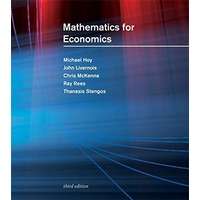Mathematics for Economics Book by Michael Hoy EPUB & PDF – eBook Details Online
- Status: Available For Free Download
- Author: Michael Hoy
- Language: English
- Genre: Popular
- Format: PDF / EPUB
- Size: 2 MB
- Price: Free
Introduction
Almost for as long as economics has existed as a subject of study,
mathematics has played a part in both the analysis and the exposition of
economic ideas.1 It is not simply that many economic concepts are
quantifiable (examples include prices, quantities of goods, and the stock of
money), but also that mathematics is a powerful means of analyzing the
relationships among these quantities. These relationships are explored in the
context of economic models, and how such models are developed is one of
the key themes of this book. Economists think, explain, and argue in terms
of models. Models do not have to be mathematical, but mathematics
possesses the precision, the logical rigor, and the capacity to deal clearly
with complex systems, which makes it very valuable as a method for
analyzing economic issues.
This book covers a wide range of mathematical techniques and outlines
a large number of economic problems to which these techniques may be
applied. However, mathematical modeling in economics has some unifying
features and conventions that we will summarize here at the outset.
Although model details are problem-specific, there are some basic
principles in the modeling process that are worth spelling out.
1.1 What Is an Economic Model?
At its most general, a model of anything is a representation. A model
differs from the original in some way, such as scale, amount of detail, or
degree of complexity, while at the same time preserving what is important
in the original in its broader or most salient aspects. The same is true of an
economic model, though unlike model airplanes, our models do not usually
take physical form.2 Instead, we think of an economic model as a set of
mathematical relationships between economic magnitudes. Capturing the
key elements of an economic problem in an abstract simplification is part of
the formal training of an economist, and this remains one of the most
challenging aspects of an economist’s work. The model must be convincing
in its relationship with reality and must be capable of addressing the
questions that the researchers have set. We set out in this chapter the central
features of an economic model.
Models do not have to be highly complex mathematically, as the
following example shows.
Example 1.1
How Keynes made a fortune for King’s College Cambridge (as well as for
himself)
Academic economists who state firm opinions about the economy are
sometimes met with the response, “If you’re so smart, why aren’t you
rich?” John Maynard Keynes is the exception that proves the rule. Not only
was he extremely smart, but also, as investment advisor to his alma mater,
King’s College, Cambridge, he made both the college and himself very rich.
It is thought that one way in which he was able to do this was by applying
his “parity theory of foreign exchange,” which allowed him to recognize
and exploit profitable opportunities of arbitrage.
Take two countries, say the United States and Canada, each of which
has a well-developed capital market for borrowing and lending in terms of
domestic currencies (U.S.$ and CA$, respectively).
For More Read Download This Book
EPUB



